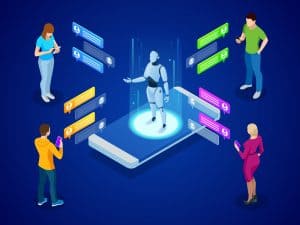
ChatOps offers employees the opportunity to take ownership of product development, collaborate across departments, and reach management more quickly.
ChatOps is poised to disrupt traditional communications channels. Ask workers and organizations what things they thought would never change in the workplace, and email is likely at the top of that list. A collaboration tool for decades, email is the reigning communication device, despite its many challenges. Then came channels and productivity software like Slack. Email’s limitations — think lost email trains, multiple conversations, accidental reply-alls — became glaring. Work continues to progress to the leanest, most efficient version of itself, so it’s no surprise that communications are getting an overhaul.
ChatOps may be the latest buzzword, but it signifies a vital concept. When organizations put conversations to work, this new collaboration could signal a revolution in the workplace.
See also: Imparting Chatbots with Multiple Conversational Styles
The basics of ChatOps
How is ChatOps different than current communication strategies? Born out of the DevOps principles of efficiency and continuous improvement, ChatOps wants to reduce the time employees spend spinning around in conversation and tie that communication to action.
ChatOps is the next evolution of productivity-focused operations. Where email threads hold a great deal of information and data in silos divorced from a specific action, new communication tools such as Slack bring that conversation to a centralized position. ChatOps takes it one step further by integrating tools.
This collaboration tool connects not just people but tools as well. Its purpose is a transparent workflow designed to tie communication to action and reduce the time team members spend chasing each other for updates or conversation. And because it incorporates deep integrations such as artificial intelligence, it also reduces manual operations.
Github pioneered the method, automating operations tasks and bringing work into an easily searchable, centralized location. People collaborate and see work not started, unfinished and in progress, or completed from one single source of truth. It provides a continuous record of the workflow, streamlining the labor employees put into simply communicating.
Putting people back in the middle
ChatOps isn’t just shiny collaboration software. At its heart, it seeks to automate what humans don’t want to do so that they’re free to do what humans are great at: problem-solving and innovation. ChatOps takes the awkward, clunky space of email away and replaces it with a real-time space in which everyone knows what everyone else knows.
Employees spend less time task switching and answering or forwarding relevant conversations. The software learns and automates repetitive tasks, building a communication strategy that eliminates the dreaded meeting loop to figure out what’s going on. No one needs to debrief for management. It’s all there in the chat.
ChatOps takes productivity further by seeking out integrations, customization, and artificial intelligence to make these chatrooms into the de facto operating system for departments. In the era of remote work, this capability provides even more profound effects.
ChatOps in response to disruption
We’ll be talking about the pandemic for years to come because it fundamentally changed the way we think about work. As teams moved remote and organizations made use of these distributed systems, ChatOps emerged as a strategy for coherence.
Gartner expects nearly 50% of employees will continue to work remotely post-COVID. ChatOps arose to address this complexity along with the increasing complexity of working with tech, data, humans, and teams.
ChatOps builds a real-time model into communication, reducing the time employees spend playing phone tag or chasing down emails. The hub includes automation like ticket resolutions, social monitoring, or customer service responses so that teams spend as little time as possible slogging through manual processes.
The benefits of ChatOps
Several advances in artificial intelligence facilitate the operationalization of team chats:
Natural Language Processing
The more computers understand human language and can respond in kind, the less training is necessary. Employees type in queries “What is the status of R&D’s second sprint for the new XX product?” and can receive an answer without disturbing the actual product team. Before, new systems required lots of downtime for training, but these newer systems are more intuitive.
Democratization
Companies democratize data in pursuit of digital transformation, so democratizing communication is a logical next step. Employees have become familiar with collaboration software, so providing deep integration with artificial intelligence transforms it from simple collaboration to an operations approach.
Non-IT departments begin to understand the benefit of this approach if they haven’t already. It’s a work in progress, still. However, with disruption like the pandemic still looming, ChatOps provides engagement and streamlined communications for ideal remote work conditions.
Improved employee experience
ChatOps isn’t just the tools. It offers employees the opportunity to take ownership of product development, collaborate with and across departments, and reach management more quickly. This seamless transition follows the DevOps commitment to continuous improvement. These intuitive workflows provide context for the conversations.
Challenges to adopting ChatOps
Some obstacles remain for ChatOps adoption.
- Security: Centralizing conversations can be risky. Organizations will need to adopt security measures that they can generalize across the board and alter as necessary.
- Access control: Teams should have control over the integrations and workflow, but department members and management should consider how much control to provide and where. Someone must have control over the conversation and its iterations.
- Ongoing adaption: More teams, more conversations, more noise, a targeted strategy for mitigating the signal-to-noise ratio. Departments could be tempted to add and monitor all conversations, but this free-for-all is no better than email.
- Old habits: Teams that haven’t already integrated chat productivity software in some form may have a learning curve overcoming the email/meeting cycle. Teams will need time to retrain their brains for the new framework.
Addressing these challenges brings companies closer to the ChatOps ideal. Organizations should also remember that continuous improvement, not immediate perfection, is the goal.
Making the Shift
Organizations switching to ChatOps should focus first on the cultural shift. Deploy ChatOps in a few small instances and note the rewards of ending the tyranny of email. Companies can choose their platform and gradually introduce the elements — the tools, chatbots, and integrations — into their daily operations.
An organization should regularly demonstrate the rewards of ChatOps. For example, error resolution times improve, or onboarding new team members or project contributors requires less labor. Soon, organizations that implement continuous improvement within the chat/communication space might leave email behind for good.



























